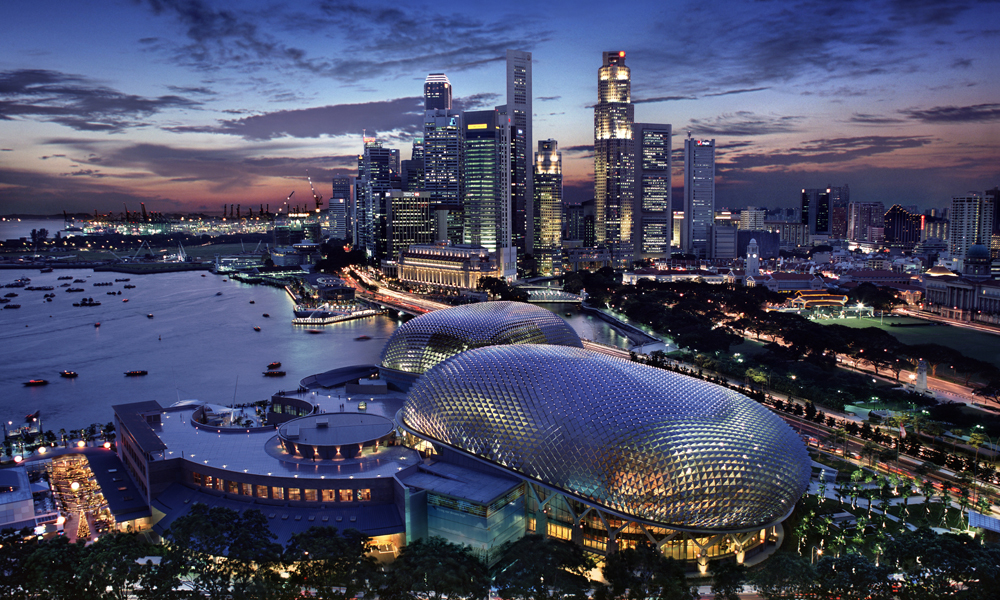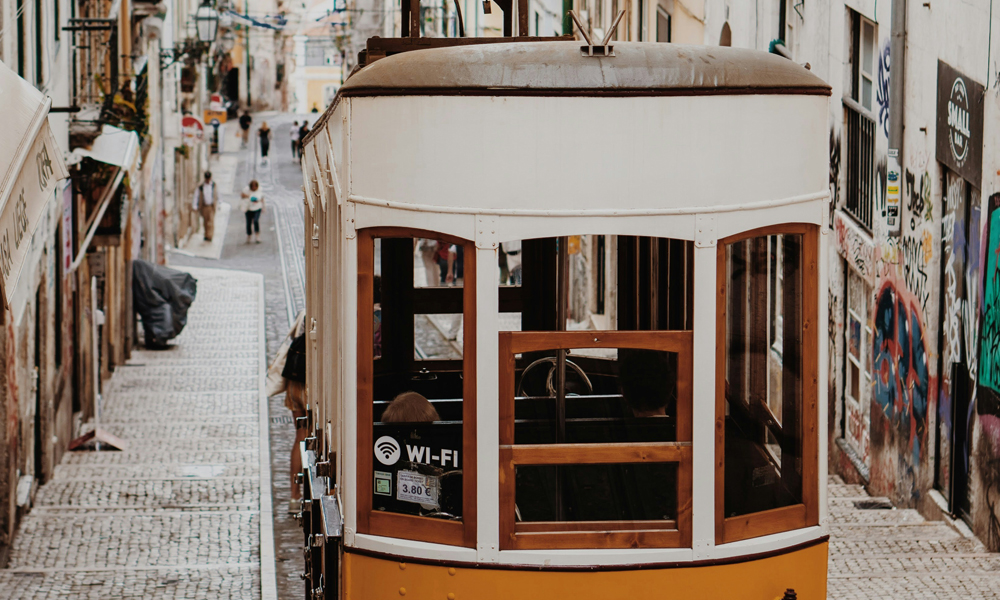This island country knows that the way to my heart is unequivocally through my stomach…
Normally, I can barely manage to choke down some yogurt for breakfast. Although I live to eat—ask anyone—breakfast is just not my jam. But in Singapore, where it is okay to have ribs for breakfast, floating alongside a head of roast garlic in a creamy pepper broth with rice and croutons, I am in heaven. Apparently, dinner for breakfast I can get right into.
We had heard that Singapore is a big food town, with a couple of dozen Michelin stars, but we weren’t expecting our pants to be too tight to wear home two weeks later. The place is a foodie’s wet dream—and one big melting pot: the Peranakan community comprises people with mixed Chinese/Malaysian/Indonesian heritage, and the culinary diversity mimics this multiculturalism. My rib breakfast at Po, the restaurant at the charming The Warehouse Hotel, was just a typical workingman’s start to the day centuries ago, but it merely scratched the breakfast surface. Throughout town, I abandon the bacon-and-eggs route every morning, devouring chwee kueh—steamed rice cakes topped with hot preserved radish relish—and chee cheong fun—steamed stuffed rice rolls done up with hoisin sauce. Fun is right! The artisanal street coffee, known as kopi, is beyond good, its beans roasted with sugar and butter. It comes with condensed or evaporated milk and there are about 15 different ways to order it, so you can customize it to your taste for strength and sweetness. One version even has a pat of butter on the bottom.
No surprise then that we soon begin stretching out the hem of our T-shirts when dressing in the morning, thinking, Uh-oh, shoulda packed the mediums.
The homespun comfort-food adventure continues throughout the day, as we move on to the hawker stalls—neighbourhood food courts with rows of little kiosks selling their own particular specialties: fried rice and fried noodle dishes with chicken or pork, curried fish, curried noodle soup, flatbread with curried dhal, coconut rice, and “carrot cake,” which is neither carrot nor cake, but a sort of omelette with diced turnip and pickled veg. Singaporeans are spoiled for choice when it comes to this homemade traditional food. No one needs to cook at home when you can have an incredible meal for three dollars. Case in point: one outlet sells the world’s least expensive Michelin-star meal. In 2016, Hawker Chan’s Hong Kong Soya Sauce Chicken Rice & Noodle became the first hawker stall to be awarded a Michelin star. The signature dish goes for just $2.50.
Impress your date with Grandma’s cooking
You don’t have to go low-end to get real home cooking; you can find it right on up the food chain, all the way to some of Singapore’s top-rated restaurants.
At Alley on 25 at the Andaz Singapore, the street-dining experience is woven into the hotel’s food and beverage concept with a meandering design that mimics the street market. Poking your head around corners reveals small kitchen stations whipping up rice, and noodle-and-meat dishes or charcoal-grilled fare.
At Wild Rocket, Chef Willin Low—one of the pioneers of this mix of modern and traditional cooking—pulls from the pages of history and from his own past. “I was a student in England and I missed food from home,” he says. “I couldn’t find all the ingredients to make it, so I mixed and matched. It never looked like Singapore food, but when I ate it, it always reminded me of home.” Willin’s experience parallels that of those from China and India who couldn’t find the ingredients they needed to make their traditional dishes when they immigrated, and just had to wing it.
“When we first opened, everyone was asking us, ‘What’s your cuisine?’ And I said, ‘I just cook what I eat.’ But everyone started calling us fusion, which is not wrong—Singaporean food is fusion—but ’80s fusion was done so badly, it was confusion,” Willin says. “I didn’t want to be associated with that, so I said, ‘Well, I’m a modern Singaporean and this is how I eat, so we’ll call the cuisine Modern Singaporean.’ We take traditional flavours and serve them on a different platform and maybe use different ingredients.”
We happily work our way through a gado gado salad with spiced peanut ice cream, a heavenly beef ravioli with ginger and spring onion sauce, and red snapper floating in a coconut milk-scented curry sauce. It is all so sublime. “We were worried people were going to say, ‘What have you done to our traditional food? You’ve ruined it,’” Willin says. He needn’t have worried.
The culinary magic continues a couple of nights later—on Valentine’s Day yet—at Candlenut, the world’s first Michelin-starred Peranakan restaurant. Here, Chef Malcolm Lee works an equally successful and similar angle, adding a contemporary twist to traditional cooking. “We want to keep it relevant and interesting, yet still keep that connection to the past, to the essence of Peranakan cooking,” Malcolm says. He looks around at the tables full of Valentines and smiles. “Getting young couples to come here and eat Peranakan food on a special occasion makes me feel good.”
We try a blue swimmer crab curry with turmeric and galangal (a ginger-like root), and a beef rib rendang with spicy fried coconut flakes. I begin to eat slower and slower, not because I’m reaching break-point, but because I want the experience to last as long as possible. We were warned in advance to save room for the black nut ice cream, which comes with a variety of chocolate trimmings. My Valentine practically rolls out of the restaurant in his little bow tie.
It’s at this point in our culinary journey through Singapore that I notice our dress shirts are button-stretching at the chest. We actually get on the treadmill a couple of mornings, something I have never done in my life. I’m not sure it helped much.
Make every night Chili Crab Night
We make a pact to go to the best place in town for chili crab, and the consensus leads us to No Signboard Seafood in the Geylang district. The restaurant’s name harkens back to the early days when the owners couldn’t afford a sign. And then when they could, there was no need: the name stuck and now there are four locations. There’s no fuss here; it’s like one big outdoor patio with plastic chairs, and they are all full. A server brings along big bottles of beers in a cart, and halfway through drinking mine, I find her at my elbow again, this time to transfer our unfinished beer into fresh, frosted mugs. Such service! When the famous crab comes, we accept bibs and dig in. It’s insanely good, but I should have used something bigger than a bib—like a barber cloth—and my trousers have to go in the wash when we get home. (Crab fail.)
With all the amazing food everywhere you look, it’s no wonder Singaporeans have distinct opinions on where to get the best crab or buns or laksa or chicken rice or coffee…or anything. Discussing food is a national pastime, a water-cooler topic hashed through daily. They can even argue about which branch of a supermarket chain is better than its other locations.
The populace also seems to be fascinated with—toast. There’s a toast café on practically every corner serving the renowned kaya toast: toasted sandwiches filled with a thick slice of cold butter and a gooey, sweet layer of kaya jam (a coconut jam made from coconut milk and eggs) plus sugar and pandan leaf. This is then served with a hard-boiled egg. The main purveyor, Ya Kun Kaya Toast, has more than 40 outlets across town. That’s a lot of toast, and you can have it any time of day—whenever you need a toast hug.
Since returning home, I’ve been scouring the international aisle in my local grocery store looking for ingredients I’m seeing in the cookbook I bought while I was away. I’ve also been salivating over Willin’s Instagram account, which is filled with images of his food adventures at home and abroad.
In the end, I didn’t actually balloon up as I had originally thought, with just three extra kilograms to contend with between now and shirts-off season. I think I can handle it.
When You Go
February to October is the dry season in Singapore, and November to January is the green season, which sees more rain. Go to VisitSingapore.com and SingaporeAir.com for more info.
—
DOUG WALLACE is the editor and publisher of travel resource TravelRight.Today.

Tucking Into Singapore
Related Articles
Travel Your Way To Better Health
Take your love of travel and combine it with a wellness goal – these five types of personal improvement getaways will have you coming home a better you
Tranquility In Mont-Tremblant
The beating heart of the Laurentian Mountains offers diverse skiing, irresistible charm and a mountain of great food
Olá Lisbon! A 2SLGBTQI+ Travel Guide Of Portugal’s Capital City
Portugal has a ton of charm and an array of activities for travellers to enjoy… By Stephan Petar A picturesque destination, Portugal is known for its architecture, food and natural...





POST A COMMENT